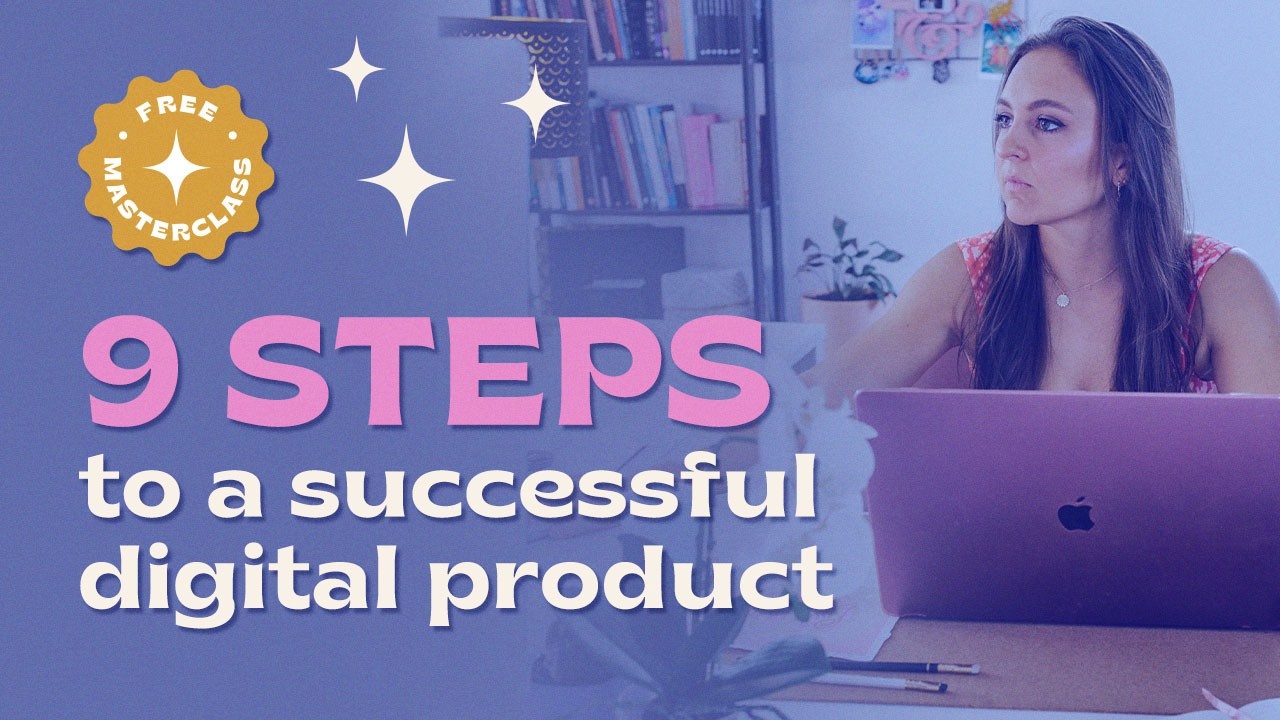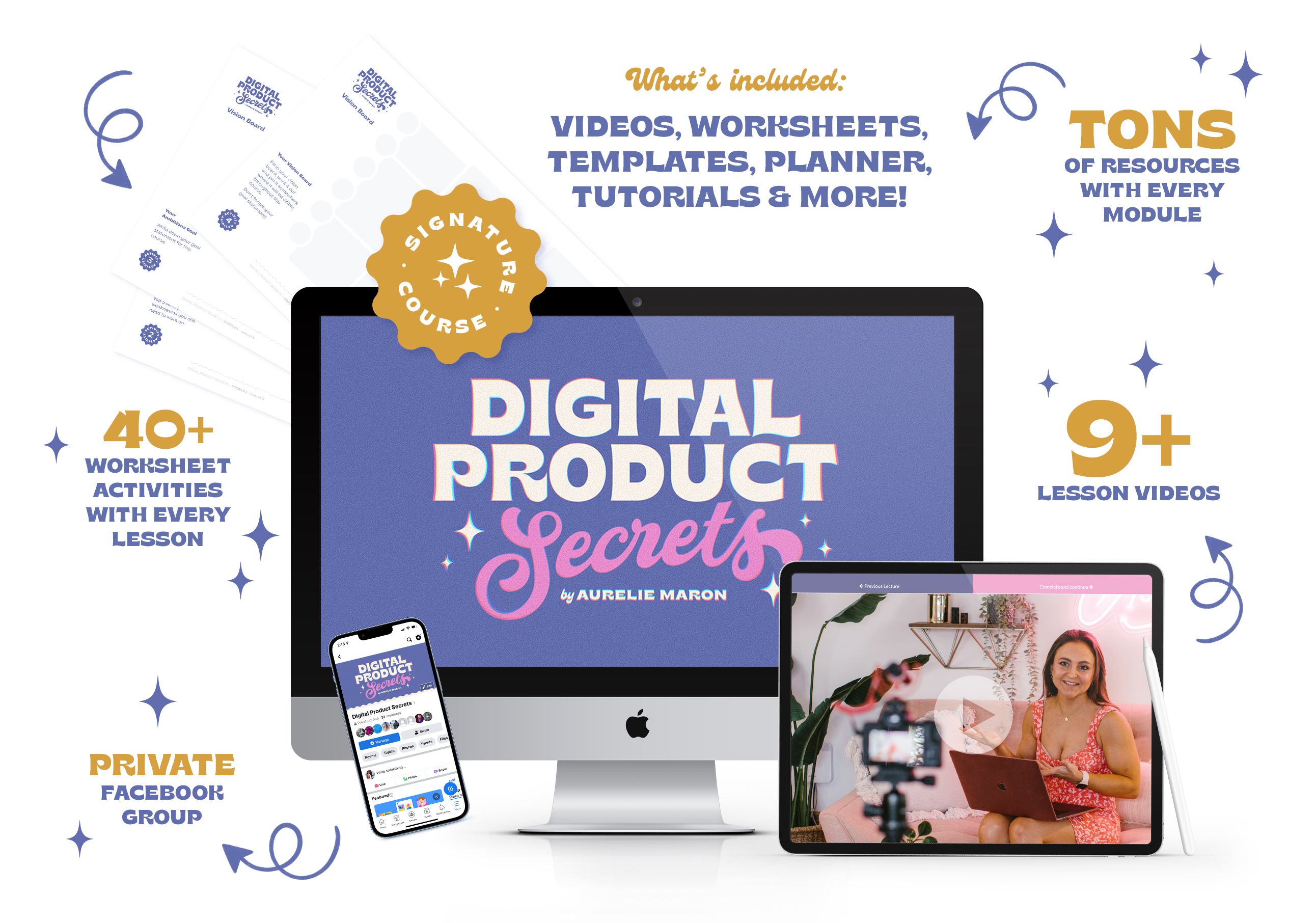How to Create and Sell your Own Digital Product
May 19, 2022
Let me guess, you're here because you’re thinking of selling your own digital products but have no idea how and where to start? We’ve all been there, but I’m here to help!
I'm Aurelie, I’m a full-time lettering artist. I have this beautiful life I never could have imagined back when I was slaving away doing freelance graphic design. I’ve doubled my income by selling digital products, which means I have more time to select the projects I want to work on and more time to focus on what I love doing the most, which is hand lettering. Now, I want to share with you all the things I’ve learned because I believe you deserve to know more about this stuff too. In this guide, I’m going to walk you through the 9 bulletproof steps you need to take to create and launch your own digital product. Are you ready?
1. Create a Vision Board
The goal of a vision board is to have a general idea of what product you wish to create. First, you will need to establish what skills you have and what your level of expertise is for each of these skills. Then you need to figure out why you want to sell this digital product. Knowing your “Why” means understanding why you do the things you do, and the reason why you must do it. As with most things in life, finding the perfect digital product to add to your business is going to be an experimentation game. There are so many options available to us designers these days — whatever you’re good at, I promise you there’s a complementary income stream out there for you.
2. Nail your Creative Brief
Any design project should be guided by a brief, and this applies to digital products as well. Writing a creative brief for your future digital product will help you put down into words what it is you’re trying to achieve and it will force you to think strategically about what your digital product needs to accomplish. Keep in mind that the process of writing a brief is non-linear: it’s OK to move back and forth between the steps as you go. You might change your mind along the way but it’s important to know where to start. As long as your brief captures the key information for your digital product, you’ll have an overview of the project, without feeling overwhelmed.
3. Start Planning and Researching
As you may know, there is nothing scarier than staring at a blank page, that’s why the more you can plan and organise your project in advance, the easier it will be to make it happen. You want to have a checklist, a step-by-step process for what you are creating. When you have a system and a process, it makes it a lot easier to just know where you are at and tick boxes. And while it’s easy to find a product that you love, finding a good digital product idea that actually sells is more of a process. Before committing too much time to your idea for a digital product, you want to validate it and make sure it’s solid. You will need to determine what it is that your target audience struggles with and how you can help them.
4. Finalise your Product Draft
Now that you’ve found the digital product you want to make, how do you actually create it? Every type of digital product is going to have a different way you can create it, and a different way you can sell it. I always like to start with a lot of sketching. The sketching process for me goes something like this: brainstorming, thumbnail sketches, refinements and then the final draft. Your final draft should be your final idea put on paper or the first mock-up version of your product. I like to think of it as the first proof I’m giving to my client. This stage is super important because it’s possibly the most difficult and the one where you’ll have the most resistance.
5. Develop your Minimum Viable Product
The next step in the design process of our digital product is implementation. That’s when the best ideas that you generated during ideation (the sketching process) are turned into something concrete. Turning your idea into something concrete will mean having to make important design decisions in order to create a minimum viable product. A minimum viable product is a version of a product with just enough features to be usable by early customers who can then provide feedback for future product development. Basically, it is the simplest core feature set of any product that allows the product to be used and nothing more.
6. Test and Repurpose your Product
Testing is an essential part of developing a quality digital product. Before you start selling or creating iterations of your digital product, you’re going to need to test the usability of your product. Once this is done, you can start repurposing your product. Repurposing a product is the practice of reusing elements of an existing product to create another product in order to expand that product’s reach. Repurposed products are typically transformed into smaller products or transformed into bigger products. This approach can be a very efficient way to make the most of your great product creation efforts.
7. Design Killer Presentation Images
Digital products are easy to sell with the right visual content. You’re going to need to find an authentic way to connect with your customers through the images that they respond to. The best selling products usually have a high level of energy and personality attached to them. Using visual images that are friendly, inviting and with a lot of energy will ensure that viewers can’t help but notice them. If your images and description are original and inventive you’ll be bringing more eyes to your digital products than ever. And if you can make your potential buyers envision themselves using your product, that’s even better!
8. Plan your Marketing Strategy
Digital products are increasingly attractive. However, with millions of new digital products being created each year, there’s an increasing amount of competition to grab people’s attention. This is no secret, if you want to be discovered, you need to share your work even if it may seem scary for some of you. Now that you’ve done the work, it’s time to share your work with your audience no matter how big or small. Your goal with your marketing strategy is to introduce your new digital product, get people eager to buy it and have a plan for it. Plan what information you’re going to release and when, and how you can turn your product launch into something worth talking about.
9. Launch Confidently!
If you’ve made it this far and are now ready for the launch phase of your digital product, congratulations! Launching a digital product is a nerve-wracking experience, but how you proceed from this point will determine how successful your product will be. No matter what you do, remember that there is never a perfect time or perfect strategy to launch your product. It is more important to launch now than to strive for impossible perfection. There are many ways you can set up a storefront but the most common ones are pre-made storefronts or custom storefronts. My advice is to set up multiple storefronts to get more eyes on your product and see where it sells best.
Want to learn more about digital products?
I have created an entire online course dedicated to helping you achieve all the steps necessary to create a successful digital product. Check it out here!








